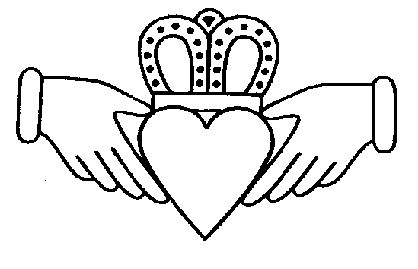Is there a tradition or story that you would like to see here? Let us know!
- Ever wondered where the name of something came from?
- Ever wondered what an Irish word or expression means?
We will be adding much more to this section as time goes on!
The Story of Brigid's Cross
The 1st of February, or the first day of Spring in Ireland, is also known as St. Brigid's Day. Making a St. Brigid’s cross on this day is a tradition in Ireland to celebrate the beginning of early spring. The crosses are normally made of rushes. St. Brigid's Crosses are commonly hung by the door and in the rafters of homes to protect the house from fire and evil. According to tradition, a new cross is made each St. Brigid's Day, and the old one is burned to protect the house from fire. Many believe that keeping a cross in the ceiling or roof is a very good way to preserve the home from fire which was always a major threat in houses with thatched or wood roofs.
St. Brigid and her cross are linked together by the story that she wove her cross at the death bed of a pagan lord in Kildare. Most versions of the tale say this chieftain was Brigid's father. Brigid went to her father's side when he fell ill, to pray for him and speak to him about Christ. When she arrived he was delirious with fever. Brigid sat down at his bedside and began consoling him in his delirium. As was customary for the time, the dirt floor was strewn with rushes both for warmth and for cleanliness. Brigid began to weave the rushes into a cross. When her father asked what she was doing, she spoke to him and his delirium quieted. Through her weaving of the cross and conversation, he converted and was baptized before he soon passed.
St. Brigid is the female patron saint of Ireland. She is also known as Muire na nGael or Mary of the Gael which means Our Lady of the Irish.
History of the Claddagh:
In the early 16th century an Irish man by the name of Richard Joyce was fishing off the coast of Galway a week before he was to be married when his currach (boat) capsized. Richard was captured by pirates, taken to West Africa and sold into slavery to a Moorish goldsmith.
Years passed and Richard escaped captivity and returned home to Ireland to find that the girl he loved had never married. Richard shaped a unique ring for the girl he left behind. The ring was fashioned of three symbols; the hands signifying Friendship, holding a heart signifying love, topped with a crown for loyalty. Richard and his love married and settled in the village of Claddagh.
The village no longer exists but since those early days the Claddagh ring has been worn as a sign of Love, Loyalty and Friendship.

